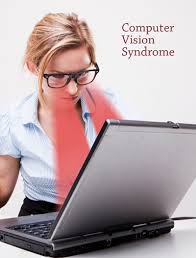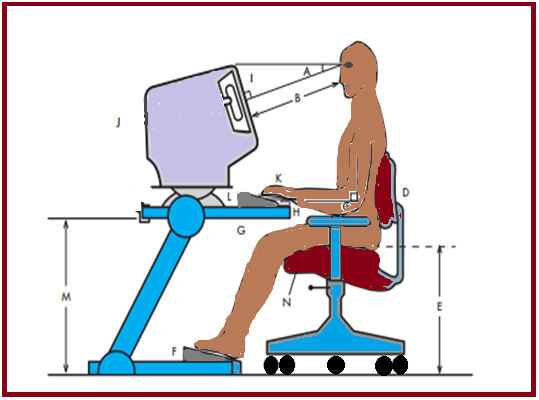Ways to reduce eye strain while working on computer
 In technical environment, humans frequently use electronic
gadgets like computers, laptops, smart phones and tablets. But,
continued use of gadgets can harm the eyes. Strain in the eye is
the most common problem and due to this users suffer from
computer vision syndrome. This syndrome is also called Digital
Eye Strain. It is often caused by excessive bright light, either
from the sunlight coming in through a window or from harsh
interior lighting.
In technical environment, humans frequently use electronic
gadgets like computers, laptops, smart phones and tablets. But,
continued use of gadgets can harm the eyes. Strain in the eye is
the most common problem and due to this users suffer from
computer vision syndrome. This syndrome is also called Digital
Eye Strain. It is often caused by excessive bright light, either
from the sunlight coming in through a window or from harsh
interior lighting.
Presently, in offices, most of the employees use computers to do official work. Working at a computer requires that the eyes constantly focus, move back and forth, and align with what users are seeing. They may have to look down at papers and then back up to type, and the eyes have to accommodate to changing images on the screen in order to create a clear picture for the brain to interpret. These exercises put burden on eye muscles.
In multinational companies, many corporate managers experience eye strain and complex vision problems when viewing a computer screen for longer periods. This condition is termed as computer vision syndrome. It can have harmful consequences on human health. Major symptoms of computer vision syndrome are as follows:
- Headaches
- Blurred or double vision
- Burning or tired eyes
- Dry eyes
- Strain in the eye
- Loss of focus.
- Neck and shoulder pain.
- Fatigue
- Sensitivity to light
- Redness in the eyes
- Vertigo/dizziness
- Polyopia
These symptoms occurs due to poor lighting conditions, glare on the computer screen, improper viewing distance, poor posture for sitting, and often a combination of all these factors.Glare on walls and finished surfaces and reflections on computer screen can be strenuous.
Diagnosis of Computer Vision Syndrome or Digital Eye Strain diagnosed:
 Computer Vision Syndrome can be diagnosed through complete eye
check-up, testing, with special emphasis on visual requirements
at the computer or digital device working distance. It may
include:
Computer Vision Syndrome can be diagnosed through complete eye
check-up, testing, with special emphasis on visual requirements
at the computer or digital device working distance. It may
include:
- Patient history to determine any symptoms the patient is experiencing and the presence of any general health problems, medicines taken, or environmental factors that may be responsible for the symptoms related to computer use.
- Visual acuity measurements to evaluate the extent to which vision may be affected.
- A refraction to determine the appropriate lens power needed to compensate for any refractive errors (near-sightedness, farsightedness or astigmatism).
- Testing how the eyes focus, move and work together. In order to obtain a clear, single image of what is being viewed, the eyes must effectively change focus, move and work in unison. This test will highlight problems that keep user’s eyes from focusing effectively or make it difficult to use both eyes together.
Effect of computer use on children's vision:
Initially, computers were used almost exclusively by adults. But gradually technology was accessible to children also. All over the world, children use computers for most of the daily activities, both for education and recreation. Children can experience similar symptoms related to computer use as adults.
Tips to alleviate strain due to use of computer:
Various factors to consider for children as well as adults using a computer:
- An eye examination: Parents are advised to make sure that the child can see clearly and comfortably. It is better go for child’s thorough eye test. For regular computer users, at least an annual eye examination is necessary. When required, refractive correction exercisesshould be provided.
- Parents must monitor that child should not use computer for longer duration. There must be a ten minutes break for every hour work. It will minimize the development of accommodative problems and eye frustration.
- Parents or guardians must carefully check the position of the computer.
- The computer monitor and the keyboard are positioned and adjusted according to child's body parameters. The screen should not be placed in a too high level in the child's field of view; the chair should not be put in too low level and the desk not in a too high level. An adjustable chair can be bought for children. A foot stool may be necessary to support the child's feet.
It is necessary that workstation design should be perfect. The main components of a computer workstation are the desk or display support, support for keyboard and mouse or other input device and the chair. A workstation should allow the users to espouse a healthy, comfortable posture without overloading the musculo-skeletal system. Therefore, the furniture should be adjustable as far as practicable. Other requirements include sufficient space on work surfaces for documents and sufficient leg room.
Figure:Good posture for working on computer

- Comfortable viewing angle, e.g. 15˚ - 20˚
- Recommended viewing distance, e.g. 350 - 600mm for text of normal font size
- Forearm and arm at about right angle
- Changeable back rest
- Adjustable seat height
- Firm foot rest if required
- Satisfactory knee clearance
- Wrist rest if required
- Screen at right angle to line of sight
- Adjustable document holder
- Wrist kept straight or at most slightly inclined
- Screen support adjustable for rotation and tilting
- Adjustable table height preferable
- Rounded or scrolled edge seat pad
- It is highly important to carefully check the lighting for glare on the computer screen.
- Windows or other light sources could create glare on the screen. When this happens, the desk or the computer screen should be turned to another direction.
- Lessen the amount of lighting in the room.
- Specialists advice that computer users can use a dimmer light instead of the bright overhead light especially for children.
Children have different requirementsfor comfortable use a computer. It is important that elders must take for precautions to help the appropriate viewing habits and guaranteethat children can use computer in comfortable position and enjoy this advanced technology.
It is recommended to replace old CRT monitor with a flat-panel liquid crystal display or an anti-reflection screen.
Computer users must adjust the display settings of computer to diminish eye strain and fatigue. Keep computer at a distance of 20-26 inches from eyes. Ensure the centre of monitor is 4-9 inches below the eye level. Adjust the brightness and contrast of the display, so that it is almost the same as the brightness of surrounding workstation. Adjust the text size and contrast for comfort, particularly when reading or composing long documents.
Usually, in order to reduce strain, black print on a white background is the best combination. It is also important to reduce the colour temperature of display as it lowers the amount of blue light emitted by a colour display for better long-term viewing comfort.
When users are working on a desktop, it is necessary that the keyboard and the mouse are below elbow level. One may also use keyboard extension board for a more comfortable typing experience. The wrist should not bend while typing.While sitting on the chair, user's feet should be firmly fixed to the ground and knees should be at a right angle or more. Keep back and shoulders straight. User’s arms should be parallel to the floor while typing.
To avoid strain while working for longer period, users must look away from computer at least every 20 minutes and gaze at a distant object (at least 20 ft away) for a minimum of 20 seconds. This is known as20-20-20 rule. Users can also look at a distant object for 10-15 seconds, then gaze at something up close for 10-15 seconds and then again look at the distant object. They must perform this activity for 10 times.
Corporate executives have to devote longer period to complete their projects. To reduce strain, they can opt for customised computer glasses, also called anti-reflective coating screen or glasses. This is especially helpful if users normally wear contact lenses, which may become dry and uncomfortable during sustained work. Computer glasses are also good if people wear bifocals or progressive lenses.
It is also suggested that users must blink their eyes frequently to avoid the problem of dry eyes. They can also use lubricating eye drops as per doctor’s advice. If the problem still persists then it is the time to seek advice from an ophthalmologist.
Articles on Health
- Laparoscopic Surgery Advantages
- Laparoscopic Surgery History
- Laparoscopic surgery Procedures
- Limitations of traditional laparoscopic surgery
- New technologies for advance laparoscopic surgery
- Non-Robotic Laparoscopic Surgery
- Robotic Laparoscopic Surgery
- Causes and remedy for dark circles in females

- Harmful impact of mobile phone on unborn baby

- Maternal health care tips

- Rheumatoid Arthritis is Most Widespread in Female
- Periodontal ailment during Pregnancy
- Anemia is prevalent in Women
- Effect of Cell phone tower radiation on human health

- Current health scenario india
- Government health policies india
- Medical facilities india
- Hospital infrastructure india
- Shortage of Medical Professionals in India
- Quality standards indian hospitals
- Indian states health statistics
- Medical expenses india
- Hospitals in Ahmedabad
- Hospitals in Bangalore
- Hospitals in Chennai
- Hospitals in Cochin
- Hospitals in Delhi
- Hospitals in Hyderabad
- Hospitals in Kolkata
- Hospitals in Mumbai
- Hospitals in Pune
- Hospitals in Coimbatore
- Hospitals in Kochi
- Orthopaedics Hospitals in India
- Diabetology Hospitals in India
- Cardiology Hospitals in India
- Infertility Hospitals in India
- Neurology Hospitals in India
- Paediatrics Hospitals in India
- Nephrology Hospitals in India
- Oncology Hospitals in India
- Antiaging foods to improve skin

- Tips for Maintaining healthy bones
- Guidelines for preventing heart disease
- Tips to reduce eye strain while working on computer
- Mental health problems among elderly people
- Health problem of piles

- Health advices for air travel

- Dealing with Allergies
- Tips for Eyes Care
- Care for Crystal Clear Skin
- Tips For Healthy Hair
- Healthy Living is The Absolute Measure of Happiness
- Let Fragrance Rule Your Summer
- Most common vestibular disorder

- Osteoporosis Risk Factors
- Dengue

- Endocrine disorder

- Causes of liver damage
- Dry eye syndrome
- Kidney Stones
- Conjunctivitis: Irritating eye disease
- Anxiety Disorder
- Causes of Brain Damage
- Hepititis B
- Knowledge of Osteoarthritis
- Mental Illness
- Back Pain
- Sugar Addiction
- Diet Control Plans
- General Motors Diet Plan
- No Carbohydrate Diet
- One day Diet Plans
- Seven day diet Plans
- Vegetarian Diet
- Food for Health
- Genetically Modified Foods
- Healing Effects Of Fruits
- Vegetables That Heal
- Healing Effects Of Spices and Herbs
- Test your Stress Level
- Mantras for Relaxation & Stress free life
- Take walk For a healthy body and mind
- Squint is frequently observed in Children
- Consult-Doctor
- Free Handy Health Advice